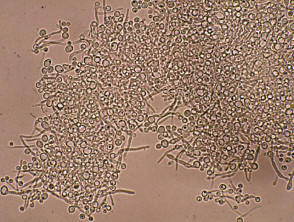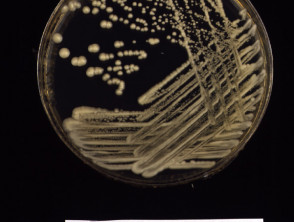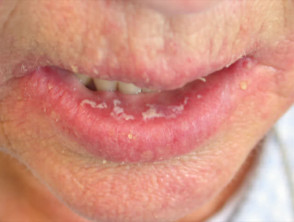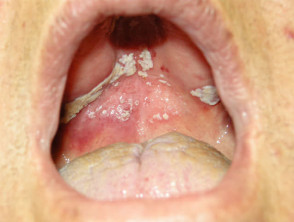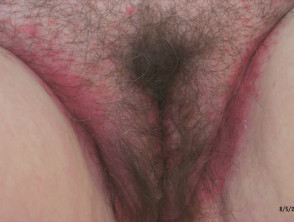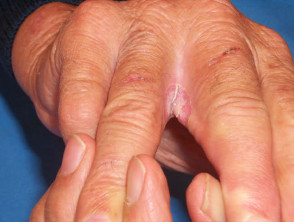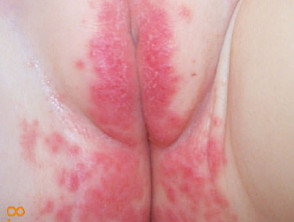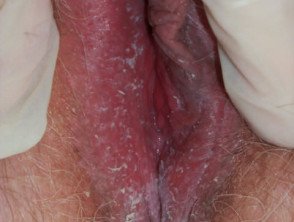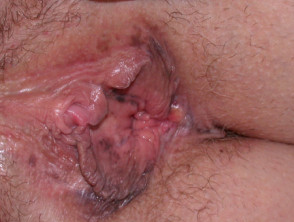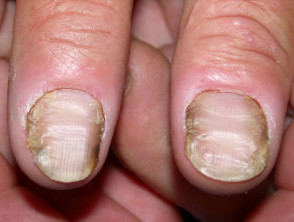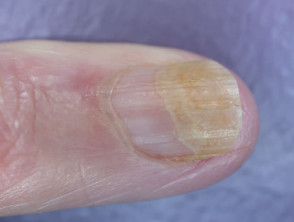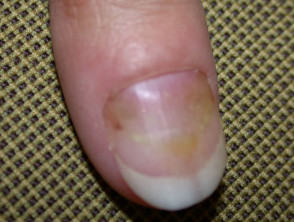DermNet provides Google Translate, a free machine translation service. Note that this may not provide an exact translation in all languages
Home Fungal skin infections Candida infection CME
Fungal skin infections
Candida infection
Created 2009.
Learning objectives
- Identify and manage candida infections of skin and mucosal surfaces.
Introduction
Candida albicans is a normal inhabitant of the human digestive tract from early infancy. Opportunistic infection with C. albicans and other Candida species (tropicalis, parapsilosis, glabrata, guilliermondii) is most likely to affect mucosae but sometimes involves skin, and rarely causes systemic disease.
Predisposing factors for infection include:
- Infancy or old age
- Warm climate
- Occlusion eg, plastic pants (babies, elderly incontinent), nylon pantyhose (women), dental plates
- Immune deficiencies eg, low levels of immunoglobulins, infection with human immunodeficiency virus (HIV)
- Broad spectrum antibiotic treatment
- High oestrogen contraceptive pill or pregnancy
- Chemotherapy or immunosuppressive medications such as systemic steroids
- Locally applied topical steroids
- Diabetes mellitus, Cushing syndrome and other endocrine conditions
- Iron deficiency
- General debility eg, from cancer or malnutrition
- Underlying skin disease eg, psoriasis, lichen planus, irritant contact dermatitis
Characteristically candida causes red and white patches on mucosal surfaces. In skin folds it results in moist fissuring with satellite superficial papulopustules.
Investigations
Microscopy and culture of smears, blue-top skin swabs and scrapings aid in the diagnosis of candidiasis. However, candida can live on a mucosal surface quite harmlessly. It may also secondarily colonise an underlying skin disorder such as psoriasis; thus positive culture does not always mean a dermatosis is candidiasis.
Infection is confirmed by the presence of yeast cells, which may be dividing by budding, and pseudohyphae (branched filaments similar to those of a dermatophyte) forming a pseudomycelium. Specific sensitivity testing can be done on request.
Candida mycology
Oral candidiasis
Candida is a commensal organism in 50% of healthy mouths. Oral candidiasis (thrush) indicates invasion of the mucosa by the yeast because of favourable conditions (dentures, smokers, antibiotics, steroid inhalers) or debility. Several clinical subtypes of infection are recognised:
- Acute candidiasis: pseudomembranous (white) and/or atrophic (red) patches
- Chronic candidiasis: atrophic or hyperplastic plaques
- Median rhomboid glossitis: diamond-shaped inflammation at the back of the tongue
- Angular cheilitis (fissured oral commissures), more likely if there is overhang of the upper lip over the lower lip. Candida may co-exist with Staph. aureus.
Oral candidiasis
Treatment of oral candidiasis is usually with oral nystatin drops or pastilles, or miconazole gel. Occasionally, oral fluconazole is necessary for severe or persistent disease.
Chronic candidiasis may be pre-malignant or confused with in-situ malignancy. Refer treatment-failures to a dermatologist or oral surgeon for diagnosis and, if necessary, biopsy.
Intertrigo
Candidiasis is particularly likely to affect flexures in warm weather especially in those who are obese. Look for mild to moderately irritating bright red plaques, skin-fold fissures, satellite spots and peeling. Specific sites for intertrigo include:
- Athlete's foot: the differential diagnosis includes tinea pedis, dermatitis, psoriasis and soft corns.
- Web spaces of the hands (erosio interdigitalis blastomycetica): usually affects gardeners and housewives.
- Submammary, inguinal or natal cleft: consider psoriasis if apparent candidiasis persists.
- Napkin dermatitis: more likely if treated with broad-spectrum antibiotics or if prone to irritant contact dermatitis from urine and faeces.
Cutaneous candidiasis
Topical therapy is usually adequate, using miconazole or clotrimazole cream. Dusting powder and antiperspirants such as 3B cream can be useful prophylactically.
Vulvovaginal candidiasis
Vaginal Candida albicans can be cultured in about 10% of asymptomatic non-pregnant women aged 15 to 55 years. Invasive vaginal candidiasis causes a heavy white curd-like vaginal discharge, a burning sensation in the vagina and vulva and/or erythema and oedema of the labia minora/majora and sometimes extending to adjacent flexures. It is frequently precipitated or aggravated by sexual intercourse.
Candidal vulvovaginitis
Although swabs can be useful in confirming diagnosis and identifying other infections, borderline or negative culture can be misleading. Non-albicans candida are fairly resistant to treatment.
Straightforward cases are treated with intravaginal pessaries and where required, topical antifungal creams. Subsidised preparations in New Zealand (April 2005) are clotrimazole 500mg single dose, or 100mg x 6 pessaries, and vaginal cream 1% or 2%; and miconazole vaginal cream 2%. It is wise to prescribe an optional repeat prescription.
Cyclic vulvovaginitis refers to recurrent thrush or thrush-like symptoms related to the menstrual cycle. There is often associated dermatitis due to rubbing (lichen simplex) and contact irritants (soaps, detergents, antifungals and many others). Underlying diseases such as diabetes and immunodeficiencies are uncommon but should be ruled out with appropriate blood tests and treated appropriately if present.
These patients require careful examination as other vulval diseases such as condylomata, lichen sclerosus, and vulval intraepithelial neoplasia may be present. Vulvodynia (burning discomfort) should be distinguished from pruritus vulvae and can be a sign of non-albicans yeast or another disease such as erosive lichen planus.
Cyclic vulvovaginitis should be treated in consultation with a dermatologist, gynaecologist or sexual health physician. Mild topical steroids such as hydrocortisone cream are often combined with intermittent oral fluconazole.
Balanitis
Balanitis may be due to candida, bacterial infections, and contact with irritants including soap, smegma, and applied preparations. It is nearly always seen in uncircumcised men and may complicate diabetes.
First line treatment may be with a mild topical steroid/antifungal/antibacterial such as Viaderm KC. Advise the patient to wash the glans with warm water alone and dry carefully and gently before replacing the foreskin.
In cases of persistent balanitis:
- Swab and prescribe specific topical agent for cultured organisms
- Consider alternative diagnoses including in-situ squamous cell carcinoma
- Circumcision may be necessary
Nail infection
Acute staphylococcal paronychia develops over a few hours and may be accompanied by fever and lymphadenopathy. Distinguish this from chronic paronychia, which is most often due to candida species. It starts in a single nail fold then often spreads to several others, later involving the nail plate. It is most likely to affect those whose fingers are cold and wet such as gardeners, fishermen and dairy farmers. Signs include:
- Red swollen and tender nail fold
- Loss of cuticle with nail fold lifted off nail bed
- Expression of small amount of white sticky pus
- Irregular transverse ridging of the nail plate
- Discoloured nail plate (white, yellow, green, black)
- Cool fingers with acrocyanosis
Swabs and nail clippings are frequently negative as the nail plate may be injured rather than primarily infected and pus is not always present. Gram negative bacterial infection may be isolated and may coexist with candida.
Management should include:
- Advice to keep the hands scrupulously clean, dry and warm.
- Emollient hand creams.
- Topical antiseptics or antifungal lotions twice daily to the nail fold for weeks to months.
Subsidised preparations include clotrimazole solution and ciclopiroxolamine nail solution. Persistent severe cases may benefit from intermittent or continuous oral fluconazole, as recommended by a dermatologist.
Candidal nail infection
Nail plate infection or onychomycosis due to candidiasis can follow chronic paronychia but it can rarely occur in its absence. Most often, candida results in onycholysis (lifting of the nail plate from the nail bed) but there are many other causes of onycholysis that may be clinically indistinguishable.
The relevance of a positive candida culture can be uncertain as it may arise in nail dystrophy due to psoriasis or ageing (in which case, antifungal agents result in no improvement). The patient is often best to consult a dermatologist for advice.
Activity
Search for evidence to support the use of yogurt to treat or prevent recurrent candidiasis.
Related information
On DermNet NZ
Information for patients
Other websites
- Medscape Reference: Cutaneous candidiasis
- Merck Manual Professional: Candidiasis
Books about skin diseases
See the DermNet NZ bookstore.
Sign up to the newsletter
© 2024 DermNet.
DermNet does not provide an online consultation service. If you have any concerns with your skin or its treatment, see a dermatologist for advice.
